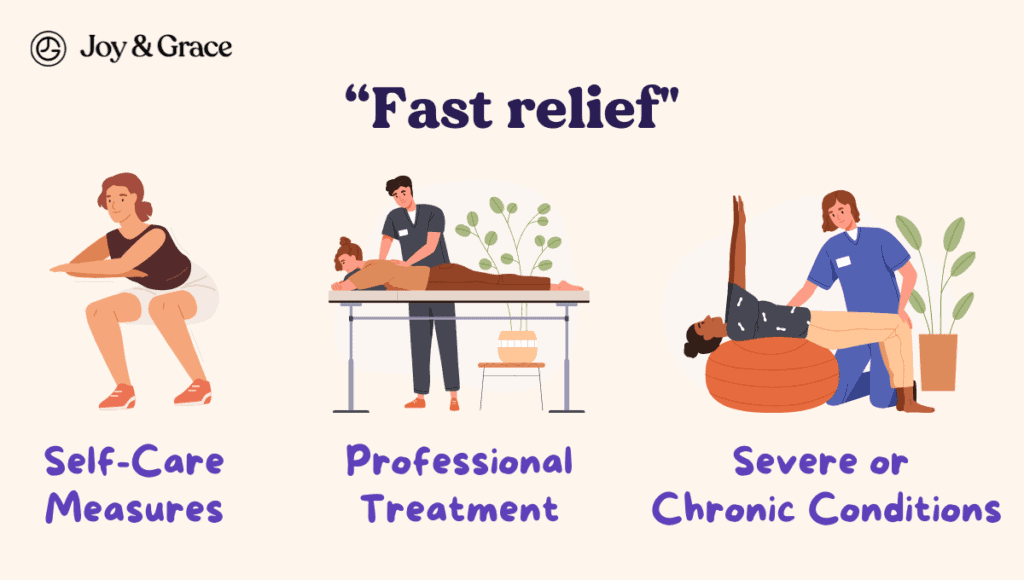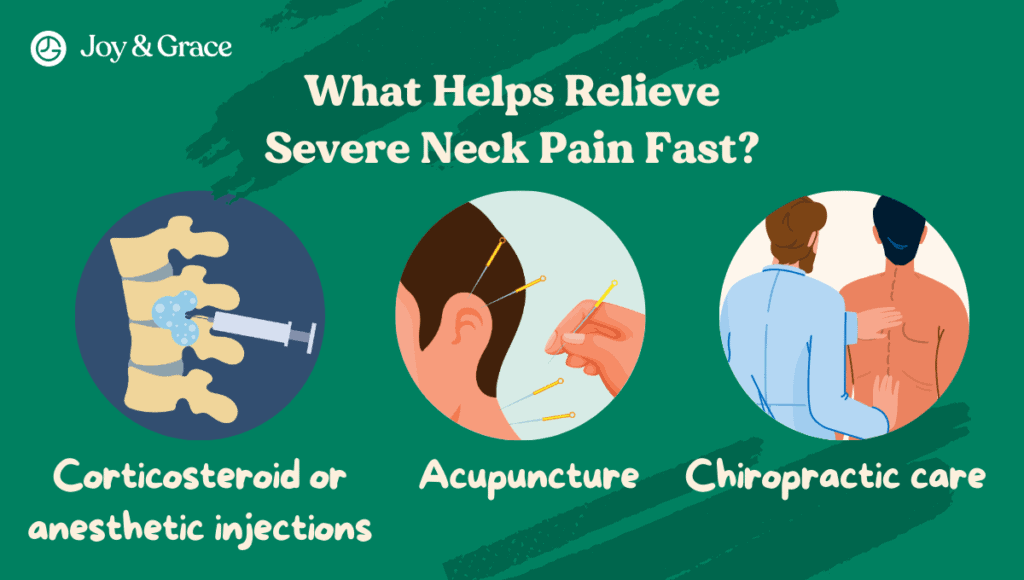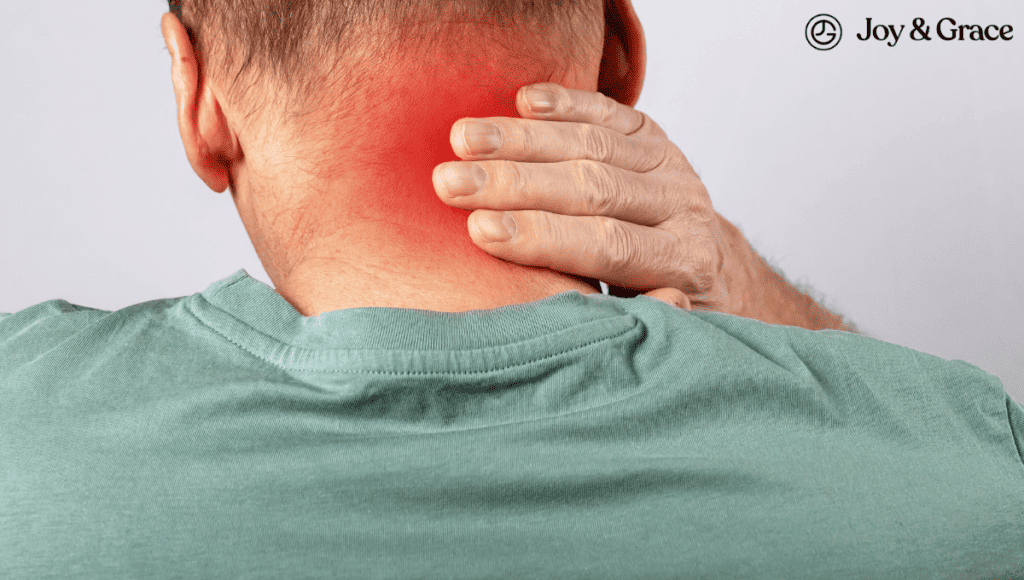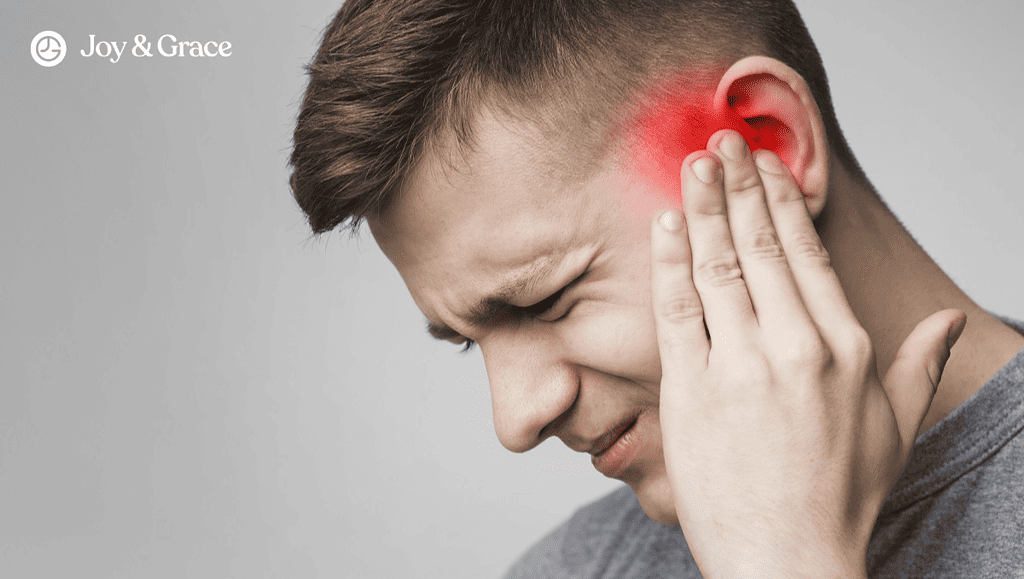If you’ve been trudging through your day with a literal pain in the neck, you might’ve been searching for a way to relieve your neck pain fast.
Well, you’re not alone. Neck pain is a widespread issue that can bog down your routine, making even simple tasks seem mountainous. Whether it's because of poor posture or a pinched nerve, we all yearn for a quick fix for neck pain.
At Joy & Grace, we aim to guide you through various strategies while setting realistic expectations about relief durations.
Is It Possible To Quickly Relieve Neck Pain?
It's important to understand that neck pain relief varies for each individual, and while some treatments might provide quick relief, others may take longer.
Hence, before we go into the what’s and how’s of fast neck pain fixes, it’s important that we set some expectations.
- Understanding the duration
While many hope for a quick resolution to their neck pain, it's essential to be aware of its typical duration. According to a journal article by the Mayo Clinic, most cases of acute neck pain will resolve within two months. However, 50% of people report having pain or recurrences even one year after the start of the pain.

- The term 'instant relief' can be misleading
People use the phrase "fast relief" in different ways. But most people think of it as getting rid of symptoms within hours or days, especially when they are talking about neck pain. However, the exact duration can vary based on the severity and cause of the pain.
a. Self-Care Measures
If you have minor neck pain due to poor posture or a mild strain, some self-care measures might provide relief within a day or two.
b. Professional Treatment
It’s crucial to seek professional medical help if the pain is more severe or results from an injury. Doctors might prescribe stronger pain medications or recommend physical therapy. In some cases, therapies like massage or chiropractic adjustments might provide immediate relief
c. Severe or Chronic Condition
For chronic neck pain conditions or serious injuries, the term "fast relief" might mean relief after just a few weeks. This is with consistent treatment and physical therapy.
In conclusion, while some neck pain can be alleviated quickly, managing expectations is crucial.
The term "fast" is relative; "as fast as possible" might be a more accurate description, given the variability in conditions.
How Can I Relieve Neck Pain Fast?
Various home remedies can provide relief for neck pain. We've discussed them comprehensively in our dedicated article here. But if you're seeking immediate solutions or feel the remedies aren't enough, consider the following extra methods:
- Over-the-counter medications
Non-prescription pain relievers like ibuprofen or acetaminophen can quickly relieve neck pain. Just make sure to follow your healthcare provider's instructions when using them.
- Muscle relaxants
Muscle relaxants can help quickly relieve neck pain due to muscle pain or spasms. They relax tense muscles in your neck, reducing neck tension, pain and stiffness. But, like painkillers, it's important to use them only under a doctor's supervision. They have potential side effects and interactions with other medications.
- Topical pain relievers
Topical pain relievers are creams, gels, or patches that you apply directly to your skin. They work by either numbing the painful area or reducing inflammation. We’ll talk more about topical pain relievers further down in the article.
- Massage
A massage can help relieve neck pain quickly for some people. Massaging the neck can relax tense muscles, improve blood circulation, and reduce neck stiffness and pain. However, its effectiveness may vary depending on the cause and severity of the pain.
In a meta-analysis (a comprehensive review of many studies), massage therapy was found to offer better immediate pain relief than other therapies. Another meta-analysis also showed that massage therapy can have immediate effects on neck and shoulder pain.
- Neck Exercises
Exercises allow you to strengthen your neck muscles. Over time, this may offer relief from neck pain. While this isn’t usually something that happens overnight, some neck exercises may offer quick relief from pain. According to a study, two specific exercises may offer relief in just minutes. Could this claim be overstated? Let's delve deeper and see.
Disclaimer: Before starting any exercise regimen, especially for the neck, it is imperative to consult with a healthcare professional. There are certain medical conditions and scenarios where neck exercises may not be appropriate or could even be harmful. If you experience severe pain, dizziness, or any other unusual symptoms while performing neck exercises, stop immediately and seek medical attention.
Aside from helping you with neck pain, these can also help relieve headaches that may accompany your neck pain. Keep in mind that these are methods that can be performed quickly but are not a one-size-fits-all solution. What works for one individual might not work for you.
If you suffer from severe neck pain, you should talk with your healthcare provider about your pain and the methods you’ve tried to relieve it. They are likely to have even more suggestions for providing immediate relief.
What Helps Relieve Severe Neck Pain Fast?

As mentioned above, severe and chronic neck pain requires medical evaluation. A healthcare professional can provide personalized advice tailored to your specific situation. Also, while some treatments may offer "fast" relief, not all guarantee "instant" long-term results. With these factors in mind, doctors might suggest the following ways to deal with neck pain:
- Corticosteroid or anesthetic injections
Corticosteroid injections, such as cortisone, can help reduce inflammation. This may help provide rapid relief from severe neck pain. Local anesthetic injections can also numb the affected area, relieving the pain immediately. A healthcare professional typically administers these injections, and they can offer long-lasting relief.
A 2017 study looked into the effect of cortisone and lidocaine shots in patients with chronic shoulder pain due to shoulder impingement. After treatment, 30 out of 34 patients reported immediate relief.
In another study, all patients suffering from pain due to a pinched nerve experienced relief within 10 minutes after a steroid injection.
- Acupuncture
Acupuncture involves inserting thin needles into specific points on the body to relieve pain. Some people report immediate relief from neck pain after acupuncture sessions.
According to a study, acupuncture can reduce pain quicker than sham or inactive treatments. It also improves neck disability in the short term compared to simply waiting without treatment.
- Chiropractic care
Chiropractors manipulate the spine and other body parts to relieve pain and improve mobility. Some individuals experience rapid relief from neck pain after chiropractic adjustments.
In one study, a single treatment of “thoracic manipulation” was described to help patients with nerve issues in the neck. According to the study, they felt less pain, moved better, and managed to undertake more exercises. These patients also experienced significant relief in their neck and upper arm symptoms for up to 48 to 72 hours after the treatment.
In another study, thoracic spine manipulation provided immediate relief for mechanical neck pain. Mechanical neck pain refers to discomfort or pain in the neck resulting from problems with the muscles, bones, or joints.
Your healthcare provider may also suggest incorporating physical therapy into your routine. Talk to a physical therapist (PT) about making an exercise program that you can stick to.
It's important to note that the effectiveness of chiropractic care can vary from person to person. You should also seek a proper diagnosis before going to a chiropractor.
Remember, these may be only temporary remedies for neck pain. If your neck pain persists or worsens, it might be time to do further investigations.
How Do I Ease Neck Pain Fast With Exercise?
Please consult with your healthcare provider before performing any of the exercises mentioned.
Two exercises have been noted for their potential to provide quick relief from neck pain. Let's discuss them.
A study found they can provide immediate relief to people with chronic neck pain in just one session, taking less than 3.5 minutes.
Note that these exercises typically involve the use of a pressure biofeedback device. This device is a simple tool that measures and provides feedback about the pressure or force you apply during exercises. It helps you learn to control muscle activity. However, you can still perform these exercises without the device.
1. Cranio-Cervical Flexion (CCF) Coordination Exercise
This exercise can help activate your deep neck muscles while minimizing the activity of your superficial neck muscles.
Position: Lie on your back (supine position) with the head resting comfortably.
Movement: Gently tuck your chin towards your chest without lifting your head. The back of your head should stay in contact with the surface.
- Feedback: Use a pressure biofeedback device under your neck to track and control the pressure. The goal is to maintain a specific pressure range, indicating the correct muscle contraction. For this exercise, it’s 22 to 30 mmHg.
- If you don’t have access to a biofeedback machine, feel for the large muscles in front of your neck using your hands. Make sure they don’t contract when performing the exercise.
Duration: Hold the contraction for 10 seconds, then release.
Repetitions: Perform ten repetitions, each lasting 10 seconds. Have a 10-second rest between contractions.
2. Cervical Flexion Endurance Exercise
This exercise can help strengthen your neck muscles while maintaining a neutral neck position.
Position: Lie on your back (supine) with your head in a neutral position (not tilted forward or backward).
Resistance:
Always consult with a healthcare professional before adding any weight to exercises.
Before you start the exercise, try to see if you can perform 12 repetitions without any pain. If you feel pain, use a biofeedback device inflated to 40 mmHg and lift your head until the pressure decreases by 10 mmHg. If performing 12 repetitions is too easy, try adding weight in half-kilogram increments until you start feeling fatigued when you hit 12 reps. This will be the resistance for the rest of the exercise.
Lift: Lift your head, focusing on keeping the neck neutral (not tilting) and lifting no more than 2 cm above the surface. Try to lift your head until the pressure drops by ten mmHg.
Intensity Adjustment: Adjust the resistance (weight or pressure) based on your ability. The goal is to find a level where you can perform ten repetitions with slight fatigue but no pain.
Speed: Lift your head for 3 seconds, then lower it back down for 3 seconds, maintaining control.
Rest: Rest for 2 seconds between repetitions. After each set of 10 repetitions, rest for 30 seconds.
Sets: Perform three sets of 10 repetitions each.
What Is the Best Pain Reliever Rub To Relieve Neck Pain Quickly?
Many people find pain reliever rubs effective for quick relief from neck pain. These topical products numb the skin or reduce inflammation in the affected area. That said, there really isn’t a “best” pain reliever rub.
Pain reliever rubs are topically (skin) applied gels, creams, or patches that contain analgesics (pain-relieving substances). These analgesics can be similar to OTC painkillers or can be plant-based extracts.
Here are some common ingredients in topical rubs that may relieve neck pain:
Over-the-Counter Pain Reliever Rubs

Menthol is a natural compound derived from peppermint oil. It creates a cooling sensation on the skin, helping to distract from the pain and reduce discomfort.
Camphor is obtained from the wood of the camphor tree. It produces a warming sensation and is often used to relieve pain and inflammation in muscles and joints.
This is an active ingredient in wintergreen oil. It has anti-inflammatory properties and provides temporary relief from minor aches and pains.
In one study, an 8-hour patch with methyl salicylate and l-menthol significantly reduced pain from mild to moderate muscle strain. According to another study, camphor and menthol have been proven to provide immediate pain relief.
These studies highlight potential relief from these ingredients, but it's crucial to understand that results can vary.
Prescription Topical Rubs
NSAIDs (Nonsteroidal Anti-Inflammatory Drugs)
Prescription-strength NSAID gels or creams contain medications like diclofenac or ketoprofen. These drugs reduce pain and inflammation by inhibiting specific enzymes in the body. According to a review, topical NSAIDs can relieve pain like oral formulations in patients with acute musculoskeletal pain.
Side note: Try to apply these using a gentle pressing motion from your neck to your upper back. By doing this, you’re also gently massaging your muscles.
When using any pain reliever rub, it's essential to follow the instructions on the packaging or from your healthcare provider. If you have underlying health conditions or are taking other medications, consult your doctor before using these products.
Takeaway
Neck pain can be a real hindrance to our daily activities, affecting our productivity and overall well-being. Thankfully, there are various methods available to address neck pain directly. Some methods to quickly relieve neck pain at home include:
- OTC painkillers or muscle relaxants
- Massage
- Neck exercises and stretches
If your neck pain is from something more serious, your healthcare provider may suggest:
- Corticosteroid injections
- Acupuncture
- Chiropractic care
It's important to note that individual responses to these methods can vary greatly. What works wonders for one person might not be as effective for another. If your neck pain persists or worsens, seeking medical advice for a proper diagnosis and treatment is crucial.















